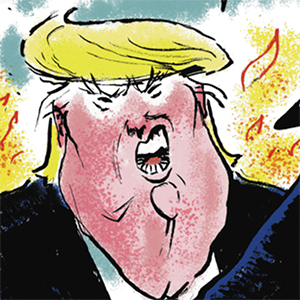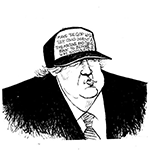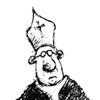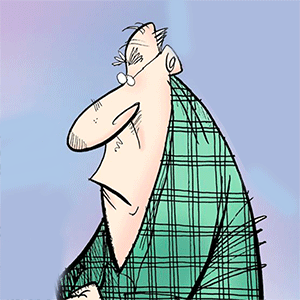How Trump and his allies on X are flooding Pennsylvania with lies in the final week of the presidential campaign
Published in Political News
PHILADELPHIA — At 12:16 p.m. Tuesday, Donald Trump’s political director, James Blair, posted an alarming message on X — siren emoji and all — about how voting was going in Pennsylvania.
“Intimidation tactics!” Blair wrote, referring to Democrats who he claimed were “running around in Bucks County” posing as election officials.
At 3:16 p.m. Wednesday, the Trump campaign emailed a news release with the headline: “Trump-Vance Campaign Discovers Leftist Activists Impersonating Election Officials.”
“Radical leftists are trying to intimidate voters and interfere with Pennsylvanians’ right to cast their ballots,” the campaign wrote, alleging that Democrats were wearing “fake badges” and “impersonating election officials to suppress the vote.”
At 8:44 a.m. Thursday, Republican vice presidential nominee JD Vance retweeted a Blair post on the same issue and added: “If you commit voter fraud, or try to deprive people of their right to vote, we will prosecute you!”
None of it was true.
There was no intimidation. No impersonation. No fake badges. No fraud. The entire ordeal was fabricated.
“These are voter protection teams doing poll watching,” said John Brady, political director of the Pennsylvania Democratic Party and executive director of the Philadelphia Democratic Party. “They’re wearing badges that say ‘PA Dems.’ We give these out to volunteers who answer FAQs. This is something that’s been done longer than I’ve been alive.”
In the final week of the presidential campaign, Trump and his allies on social media have been bombarding Pennsylvania — perhaps more than any other state in the nation — with unfounded and, in some cases, knowingly false claims of voter fraud and election interference.
On Wednesday alone, Northampton County officials had to debunk a viral video of a man dropping off ballots that purported to be evidence of voter fraud (it was just the postmaster doing his job), while Allegheny County officials responded to a video claiming that “foreigners” had cut the line to vote (they hadn’t, and only U.S. citizens can vote).
And on Friday, as the deadline approached to request an in-person mail ballot in Bucks County, GOP activists Scott Presler and Jack Posobiec began posting to X suggesting, with no evidence, that the long lines may be an intentional act of voter suppression.
“We also have people on the inside feeding us information. Any illegal activities will be caught,” Presler posted on X to his 1.7 million followers. (There has been no indication of any illegal activity.)
Meanwhile, Trump was fanning the flames in Pennsylvania last week on his social media platform, Truth Social, spreading unfounded or false claims about fraud in York and Lancaster Counties.
“Really bad ‘stuff.’ WHAT IS GOING ON IN PENNSYLVANIA???” Trump wrote Monday. “Law Enforcement must do their job, immediately!!! WOW!!!”
Kelsey Suter, director of the Center of Digital Influence at the Drive Agency, a social impact consulting firm, said Pennsylvania has become ground zero for social media content referencing voter fraud and election interference — much of it untrue or misrepresented.
“Right after early voting started, the Pennsylvania line on our chart shot up,” said Suter, an expert in countering propaganda and disinformation.
Suter said on Friday that the spike in Pennsylvania activity is particularly pronounced on X, which is owned by Trump supporter Elon Musk. (An hour later, Musk posted a false statement about “election interference by the Democrats in Bucks County.” It raked in more than 3 million views in a couple of hours.)
“We’re seeing a flood-the-zone strategy,” Suter said. “It is clearly meant to convey this idea of where there is smoke there is fire — and hiding the fact there is no fire.”
The blitz of misinformation and disinformation appears aimed at energizing Trump voters by convincing them that Democrats are trying to steal the election — while laying the groundwork for claiming that if Vice President Kamala Harris wins, the election was rigged.
“There are bad actors out there who want to sow doubt about our elections in case the election doesn’t go their way,” said Philip Hensley-Robin, executive director of good-government group Common Cause Pennsylvania. “Good-faith skeptics, when they look into it, they find out our elections are actually more secure here in Pennsylvania than they have ever been.”
The Trump campaign did not respond to The Inquirer’s requests for comment. Karoline Leavitt, a spokesperson for the campaign, told Politico in a statement: “Our election integrity team has been notified of legitimate instances of voter fraud and voter suppression by real voters on the ground. While the media labels these examples as conspiracy theories, Team Trump and the [Republican National Committee] are taking every allegation seriously to ensure a safe and secure election for ALL Americans, regardless of who they are voting for.”
Harris’ advisers see Trump’s throw-everything-at-the-wall approach this late in the game as a sign that his ground operation has petered out in Pennsylvania.
This playbook, of course, is not new for Trump.
For weeks leading up to the 2020 election — and the tense days that followed while the nation waited on word of who would emerge the victor in Pennsylvania — Trump and his allies used social media and conservative news outlets to spread half-reported claims of malfeasance in the state.
They pointed to routine irregularities — the type of small errors that are caught and corrected in every election cycle — and in some cases cited outright falsehoods as evidence of widespread fraud. And they amplified false claims from partisans portraying routine and lawful actions by elections administrators as attempts to steal the election.
Weeks after the November 2020 election, State Sen. Doug Mastriano, a Trump ally, helped circulate on Twitter a false claim that more Pennsylvanians voted by mail in 2020 than had requested ballots.
Journalists quickly debunked it, noting that Mastriano had compared the 1.8 million ballots requested during that year’s primary against the 2.6 million ballots returned during the general election.
Still, Trump widely shared that claim on Twitter, and his lawyer, Rudy Giuliani, later cited the false statistic in his suit seeking to overturn results in the state. That tweet is still online today.
When Jesse Richard Morgan, a York County contractor for the U.S. Postal Service, claimed he’d driven a truck full of 200,000 already filled-out mail ballots from New York to Pennsylvania that he believed were destined for Philadelphia, Trump quickly shared his story on social media, claiming evidence of fraud. The contractor appeared on Sean Hannity’s Fox News program that night.
It later emerged in court filings that Morgan’s certainty he’d been an unwitting agent of fraud had been based on little more than vague suspicions he harbored that a man he could only identify as “Buffalo Bill” had loaded his truck up with fraudulent ballots. It was Morgan’s mother who had — based on nothing more than a hunch — put the idea into his head that the ballots were headed to Philadelphia, the contractor said.
For months, those types of stories continued to be cited in lawsuits by Trump and his allies long after they had been debunked. They argued that whether or not the claims were proven, there was enough suspicion and uncertainty surrounding the validity of the state’s results to justify delaying certification, potentially disenfranchising Pennsylvania’s nearly 7 million voters.
State and federal judges — some of whom were Trump appointees — flatly rejected what one court described as a “Frankenstein’s Monster” of “strained legal arguments … and speculative accusations … unsupported by evidence.”
But in the public perception, the damage had already been done. Some of the same debunked information Trump amplified from Pennsylvania in the waning days of the 2020 campaign is still cited this election cycle.
“Donald Trump has made clear that he’s going to target Pennsylvania voters and is sowing the seeds of doubt in an attempt to subvert the results of the election,” Neil Makhija, a Democratic commissioner in Montgomery County who chairs the Board of Elections, said Wednesday after Trump posted on Truth Social that “Pennsylvania is cheating, and getting caught, at large scale levels rarely seen before.”
Republicans have also exaggerated cases of potentially fraudulent voter registration applications by claiming widespread cheating in the state. Days after Lancaster County announced it was reviewing 2,500 voter registration applications, some of which showed signs of fraud, Trump falsely claimed the county was “caught with 2600 Fake Ballots and Forms, all written by the same person.”
“It’s part of a pattern that we’ve been faced with for many years,” former Pennsylvania Secretary of State Kathy Boockvar said last week of the false claims surrounding the bogus voter registration documents.
“They don’t care what the truth is, or the impact of their lies,” Boockvar said. “People believe them, and then it continues this deliberate effort to tear down faith in our elections, to tear down faith in our democracy, to tear down faith in our election officials.”
The state Attorney General’s Office said Thursday that it is looking into the source of the fraudulent voter registration documents and mail-in ballot applications in Berks, Lancaster, Monroe and York counties.
Jim Allen, the elections director in Delaware County, said his office has been in steady contact with local prosecutors over bad registrations. However, Allen said, administrators routinely catch faulty voter registrations every presidential election year.
Elections officials said these are signs that the system is working, because fraudulent forms are being rooted out before individuals can register and vote.
Fraudulent registration forms can sometimes be submitted by people working for voter turnout groups who are paid based on the number of forms they submit. In order to vote in Pennsylvania, first-time voters must provide identification, making it less likely that a fraudulently filed form would lead to a vote cast.
And, as a reminder that (the social media platform formerly known as) Twitter is not real life, a Monmouth University poll released last week found that 7 in 10 voters are very (43%) or somewhat (28%) confident that the 2024 election in Pennsylvania will be conducted fairly and accurately.
———
(Staff writers Julia Terruso and Fallon Roth contributed to this article.)
———
©2024 The Philadelphia Inquirer. Visit inquirer.com. Distributed by Tribune Content Agency, LLC.




























































Comments